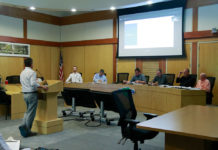Has there ever been such a fraught election? The aura of uncertainty that hung over the Democratic Primary dogged many west county voters all the way to polling place, with many undecided until the last minute.
In the end, Sanders won the day in Sonoma County with 30.15%, followed by Biden at 20.02%, Bloomberg at 16.86% and Warren at 13.7%. By morning, Bloomberg had left the race, promising to throw all of his resources behind Biden. In the Republican Primary, President Donald Trump won with 83.99% of the vote in Sonoma County.
In local candidate races, 5th District Supervisor Lynda Hopkins sailed to victory with 79.81% of the vote, while Assemblyman Marc Levine won with 55.99% approval. Congressman Jared Huffman also won handily with 65.11% of the vote.
Member of the Assembly — 10th District
|
| |
VOTES |
% |
| Marc Levine |
23,787 |
55.98% |
| Veronica Jacoby |
7,169 |
16.87% |
| Ted Cabral |
1,488 |
3.50% |
| Ron Sondergaard |
9.951 |
23.42% |
| |
County Supervisor — 5th District
|
| |
VOTES |
% |
| Lynda Hopkins |
14847 |
79.81% |
| Mike Hilber |
3599 |
19.35% |
| |
| |
West county measures
Results were mixed with local bonds and parcel taxes in west county.
Sebastopol Union’s Measure E, a general obligation bond for facilities, cleared the hurdles with 62% of the vote (it needed at least 55%), and by Wednesday morning, Superintendent Linda Irving was ready to declare victory.
“We are so appreciative of the support from the community,” she said. “Our schools are treasures and with solid facilities, our students and families greatly benefit.”
By the end of the evening, Measure M (the high school parcel tax) was a couple of percentage points shy of victory: 65.36% in favor and 34.64% against. This measure requires 67% approval to pass, but with many mail-in ballots yet to be counted, it’s still too close to call.
“There are still votes to be counted,” said Jim Walton, coordinator for Measure B. “Mail-in ballots and military ballots could be mailed up until yesterday. Currently, we are 179 votes shy of passage. There is a slim chance these votes (which are typically favorable) could take us over the finish line with a win.”
Measure B would raise $1.8 million for local high schools via a $79 a year parcel tax. The failure of this measure would have a dire effect on the West Sonoma County Union High School District, which is already facing a budget shortfall of over $400,000. The failure of Measure B would require the district to cut more than $1.2 million from its budget for next year.
| West Sonoma County Union High School District — Measure B |
| To renew and provide stable funding that the State cannot take away; maintain and improve the schools’ woodshop, culinary, media and other career technical education programs; keep school libraries open; and maintain/improve the schools’ art, music and drama programs; shall the West Sonoma County Union High School District measure to levy $79.00 per parcel annually for eight years be adopted, raising $1,810,000 annually, have no funds for administrators’ salaries, provide a senior citizens’ exemption and have all funds stay local? |
| 66.67% required to win |
VOTES |
% |
| Yes |
8887 |
65.36% |
| No |
4711 |
34.64% |
| |
| |
Sebastopol Union School District — Measure E
|
| To improve the quality of local schools; increase energy-efficiency by installing solar panels; make health and safety improvements; and modernize outdated classrooms, restrooms and school facilities; shall Sebastopol Union School District’s measure be adopted authorizing $17,500,000 in bonds at legal interest rates, generating approximately $1.0 million annually while bonds areoutstanding with levies of approximately 2.5 cents per $100 assessed value, with annual audits, citizens’ oversight, no money for salaries and all money for local projects? |
| 66% required to win. |
VOTES |
% |
| Yes |
2046 |
62.38% |
| No |
1234 |
37.62% |
| |
| |
County and state measures recap
Two county-wide and one state-wide ballot measure were up for vote on Tuesday, March 3, and the decision of the voters isn’t entirely clear.
In part this is due to close races, and in part this is due to the large number of mail-in ballots still to be counted, which in closer races could have an impact on the final outcome. State elections now work on the so-called E+3 system, which means registrars have to count ballots received up to three days after the election, provided they are postmarked on or before election day.
Eighty percent of county voters have mail-in ballots, and only 31% of those had been returned prior to Tuesday.
The results will not be certified until March 31, 28 days after the election. All vote counts listed below are as of 8 a.m. on March 4.
Measure I
The vote on Measure I split almost 50-50, with 50,855 against and 50,606 in favor, however, a two-thirds majority is required for adoption.
“Mathematically we don’t think we’ll get there,” said SMART board member Debora Fudge.
Measure I asked voters whether the existing quarter-cent sales tax for SMART should be extended for an additional 30 years through March 31, 2059. If approved, Measure I would provide approximately $40 million annually, according to the county counsels’ impartial analysis published in the voter guide.
The argument between the two sides grew heated as the campaign wore on, with huge amounts of money being thrown around on both sides. Opponents believed the level of rider subsidization through extended tax debt and lack of transparency into finances. Proponents felt that the refinancing of current bonds and the increased availability of grant funding following the refinancing will allow them to complete the route faster and remain solvent well into the future. The refinanced bonds would have saved tax payers $12 million a year.
“This has been an election like no other,” said Fudge. “While we’re disheartened by the outcome, we’re going to continue to move forward with the work the community has entrusted us with. We have to work to increase awareness of the value the train adds to the community.”
Fudge says the board will now have to evaluate where they go from here.
“We have a meeting March 18, and we’ll begin the difficult process of identifying where we can make cuts. It won’t be easy, but as a community we’ll navigate this difficult stretch; and the community will be able to have input through the meetings and the citizens’ oversight committee to review proposed budget cuts.”
Measure G
Measure G is in the same boat, though unlike I, it had an easy majority, 62,564 votes in favor versus 38,714 against. Measure G also needs a 66% majority to pass (it currently has 61%), so it is likely to go down to defeat.
Measure G would have added a half-cent to sales tax throughout the county and was born out of a recognition that the current county-wide fire and emergency service delivery structure, funding and system structure is inadequate and does not meet National Fire Protection Association (NFPA) standards.
The Sonoma County Board of Supervisors and fire officials made the rounds at local city council meetings, pitching Measure G to the local municipalities. Among the items the measure would fund include a substantial increase in staffing throughout the local fire system, adding 200-plus full-time staff throughout the county, including firefighters, vegetation management and fire prevention staff and additional battalion chiefs for regional command and control leadership.
No official “against” campaign was mounted against Measure G.
Proposition 13
State-level Proposition 13 asked if the state could sell $15 billion in general obligation bonds to fund school, community college and university facility projects. In addition, school districts and community college districts would be authorized to issue additional local bonds and school districts would have new limits on their ability to levy developer fees.
Nine billion dollars would go to public schools, mostly for renovation projects, and $6 billion will go to public higher education facilities, split evenly between community colleges, the California State University system and the University of California system. The bond is projected to cost $740 million a year over 35 years to repay the principal with interest.
While there was some panic due to the unfortunate name, and fears that voting on it would effect the landmark 1978 measure which cut property taxes, in general there has been minimal argument against other than a general dissatisfaction with additional taxes.
Possibly because of the name issue, the measure was soundly defeated, with statewide numbers showing 55.9% against and 44.1% for. Locally, the numbers were closer with 50.61% in favor, and 49.39% against.
Measure G – Sonoma County
|
| 67% required to win. |
VOTES |
% |
| Yes |
62564 |
61.77% |
| No |
38714 |
38.23% |
| |
| |
Measure I – Sonoma County
|
| 67% required to win. |
VOTES |
% |
| Yes |
50,606 |
49.88% |
| No |
50,855 |
50.12% |
| |
| |
Prop 13 — California
|
| Simple majority required to win. |
VOTES |
% |
| Yes |
50628 |
50.61% |
| No |
49410 |
49.39% |
| |
| |









